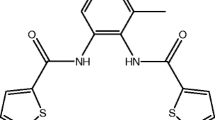Abstract
This work focuses on the synthesis of novel modified core–shell CdTe/CdS quantum dots (QDs) and develops as a fluorescence sensor for glucose determination. The (E)-2,2'-(4,4'-dioxo-2,2'-dithioxo-2H,2'H-[5,5'-bithiazolylidene]-3,3'(4H,4'H)-diyl)bis(3- mercaptopropanoic acid) (DTM) as a new derivative of thiazolidine was synthesized and characterized and used to surface-modification of CdTe/CdS QDs. DTM-capped CdTe/CdS QDs used to immobilization of glucose oxidase (GOD). The intensity fluorescence emission of the CdSe/CdS-DTM/GOD is highly sensitive to the concentration of H2O2 as a byproduct of the catalytic oxidation of glucose. The experimental results showed that the quenched fluorescence was proportional to the glucose concentration within the range of 10 nM—0.32 μM under optimized experimental conditions. The limit of detection of this system was found to be 4.3 nM. Compared with most of the existing methods, this newly developed system possesses many advantages, including simplicity, low cost, and good sensitivity.
Graphical abstract










Similar content being viewed by others
Availability of Data and Material (Data Transparency)
The data that support the findings of this study are openly available in the public domain.
References
Ye N, Kou X, Shen J, Huang S, Chen G, Ouyang G (2020) Chem BioChem 18(2585):2590
Wu XL, Hou M, Ge J (2015) Catal Sci Technol 5:5077–5085
Mateo C, Palomo JM, Fernandez-Lorente G, Guisan JM, Fernandez-Lafuente R (2007) Enzym Microb Technol 40:1451–1463
Rodrigues RC, Ortiz C, Berenguer-Murcia A, Torres R, Fernández-Lafuente R (2013) Chem Soc Rev 42:6290–6307
Salimi A, Compton RG, Hallaj R (2004) Anal Biochem 333:49–56. ht
Miao F, Lu X, Tao B, Li R, Chu PK (2016) Microelectron Eng 159:153–158
Salimi A, Sharifi E, Noorbakhsh A, Soltanian S (2007) Biosens Bioelectron 22:3146–3153
Salimi A, Hallaj R, Soltanian S (2009) Electroanalysis 21:2693–2700
Aldea A, Jose R, Leote B, Matei E, Evanghelidis A, Enculescu I, Diculescu VC (2021) Microchem J 165101068
Xia H, Li N, Zhong X, Jiang Y (2020) Metal-organic frameworks. Front Bioeng Biotechnol 8:695
Gan JS, Bagheri AR, Aramesh N, Gul I, Franco M, Almulaiky YQ, Bila M (2021) Int J Biol Macromol 167:502–515
Zucca P, Sanjust E (2014) Molecules 19:14139–14194
Smith AM, Nie S (2010) Acc Chem Res 43:190–200
Wang X, Ruedas-Rama MJ, Hall EAH (2007) Anal Lett 40:1497–1520
Cui L, He XP, Chen GR (2015) RSC Adv 5:26644–26653
Wu W, Zhou T, Berliner A, Banerjee P, Zhou S (2010) Angew Chemie Int Ed 49:6554–6558
Singh P, Prabhune AA, Ogale SB, Guin D (2013) J Mater Chem B 47:6538–6543
Wu P, He Y, Wang H-F, Yan X-P (2010) Anal Chem 82:1427–1433
Jung EY, Ye JH, Jung SH, Choi SH (2016) J Nanomater 2016:1–9
Shiang YC, Huang CC, Chang HT (2009) Chem Commun 23:3437–3439
Qadri H, Qureshi MF, Mir MA, Shah AH (2021) Microbiol Res 247:126725
Crane PK, Walker R, Hubbard RA, Li G, Nathan DM, Zheng H, Haneuse S, Craft S, Montine TJ, Kahn SE, McCormick W, McCurry SM, Bowen JD, Larson EB (2013) N Engl J Med 369:540–548
Chen L, Hwang E, Zhang J (2018) Sensors (Switzerland) 18:1–21
Batool R, Rhouati A, Nawaz MH, Hayat A, Marty JL (2019) Biosensors 9:1–19
Farough Nasiri SA, Zolali A (2012) J Heterocycl Chem 49:1458–1461
Peng H, Zhang L, Soeller C, Travas-Sejdic J (2007) J Lumin 127:721–726
Rahman Hallaj SZ, Hosseinchi Z, Babamiri B (2019) Spectrochim. Acta Part A Mol Biomol Spectrosc 216:418–423
Hu M, Tian J, Lu H-T, Weng L-X, Wang L-H (2010) Talanta 82:997–1002
Cao L, Ye J, Tong L, Tang B (2008) Chem -A Eur J 14:9633–9640
Medintz IL, Clapp AR, Mattoussi H, Goldman ER, Fisher B, Mauro JMS (2003) Nat Mater 2:630–638
Peng H, Zhang L, Kjällman THM, Soeller C (2007) J Am Chem Soc 129:3048–3049
Wu L, Zhong Lin Z, Ping Zhong H, Mei Chen X, Yong Huang Z (2017) Sens Actuat B Chem 239:69–75
Tang Y, Yang Q, Wu T, Liu L, Ding Y, Yu B (2014) Langmuir 30:6324–6330
Ding L, Zhang B, Xu C, Huang J, Xia Z (2016) Anal Methods 8:2967–2970
Acknowledgements
The financial support of the Iranian Nanotechnology Initiative and Research Office of the University of Kurdistan are gratefully acknowledged.
Funding
The authors declare that, this research received no specific grant from any funding agency.
Author information
Authors and Affiliations
Contributions
All authors contributed to the study conception design and data acquisition.
Corresponding author
Ethics declarations
Ethics Approval (Include Appropriate Approvals or Waivers)
All studies were conducted in accordance with principles for human experimentation.
Code Availability (Software Application or Custom Code)
There was not use any new software application or custom code in our report.
Additional Declarations for Articles in Life Science Journals that Report the Results of Studies Involving Humans and/or Animals
This article does not contain any studies involving human participants.
Conflicts of Interest/Competing Interests (Include Appropriate Disclosures)
The authors declare that they have no known competing financial interests or personal relationships that could have appeared to influence the work reported in this paper.
Additional information
Publisher's Note
Springer Nature remains neutral with regard to jurisdictional claims in published maps and institutional affiliations.
Rights and permissions
About this article
Cite this article
Hallaj, R., Hosseinchi, Z. Surface-Modified Colloid CdTe/CdS Quantum Dots by a Biocompatible Thiazolidine Derivative as Promising Platform for Immobilization of Glucose Oxidase: Application to Fluorescence Sensing of Glucose. J Fluoresc 31, 1805–1813 (2021). https://doi.org/10.1007/s10895-021-02805-1
Received:
Accepted:
Published:
Issue Date:
DOI: https://doi.org/10.1007/s10895-021-02805-1




